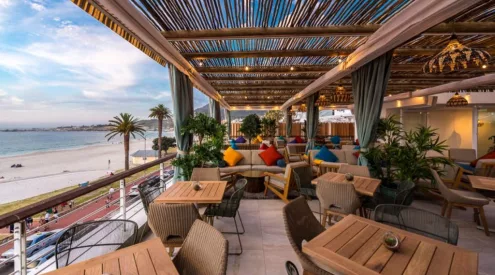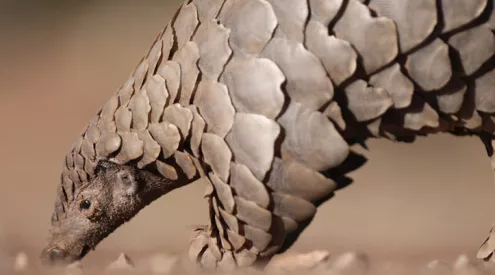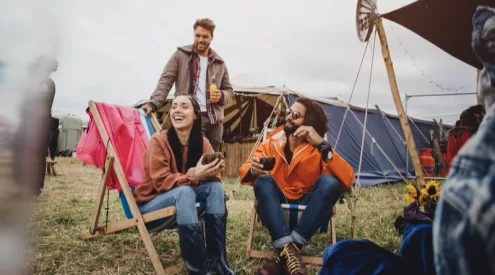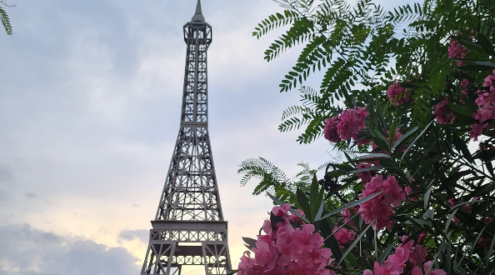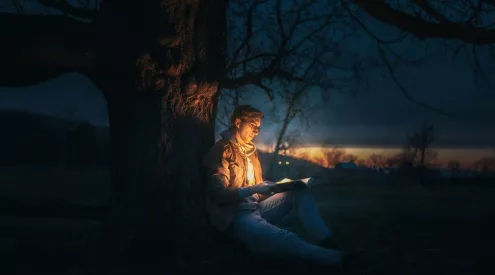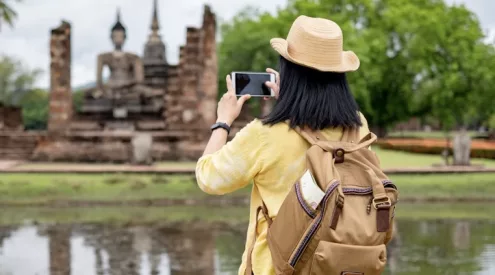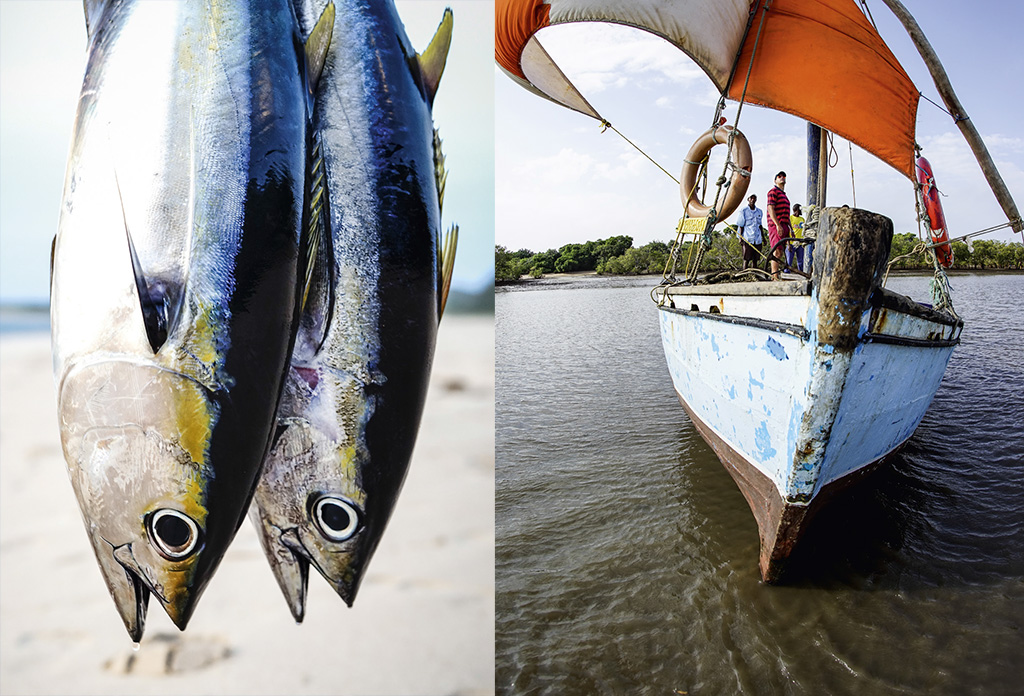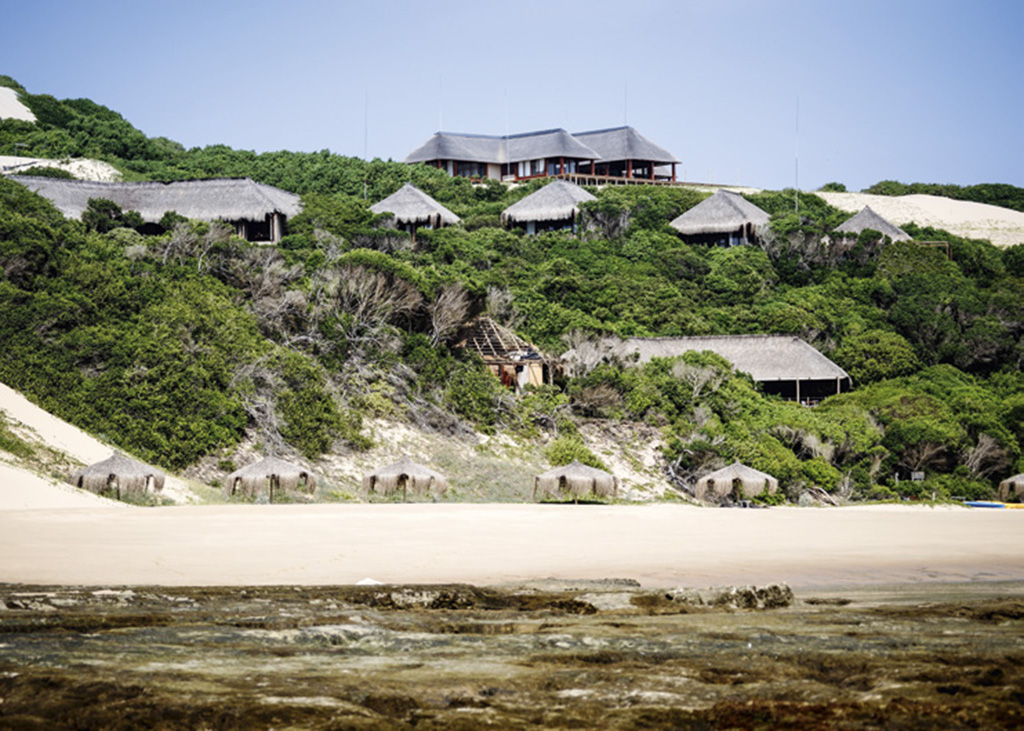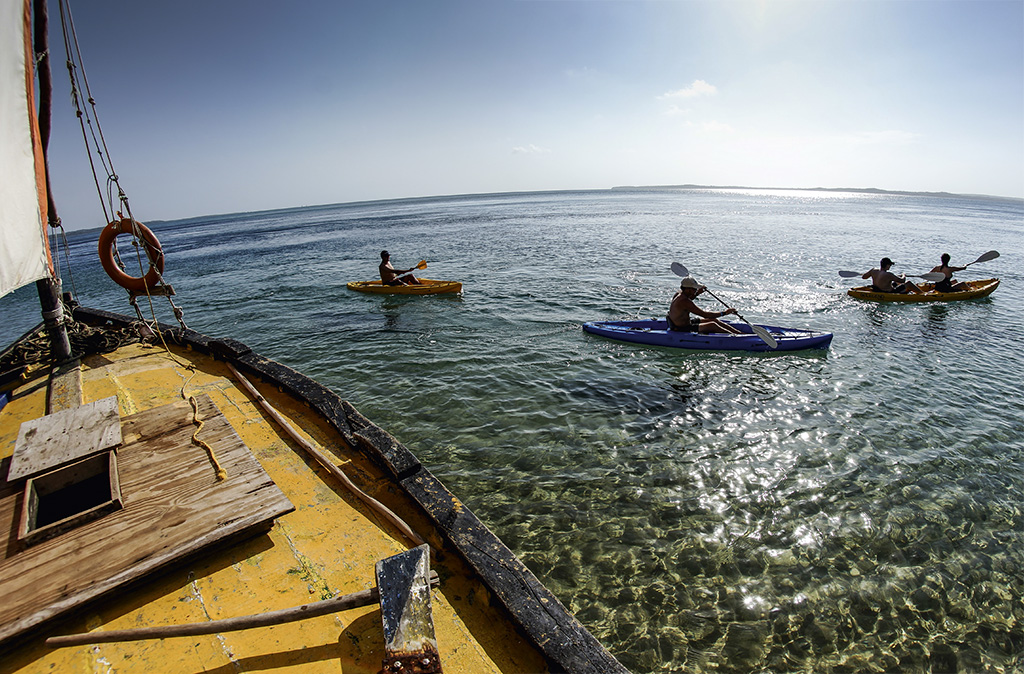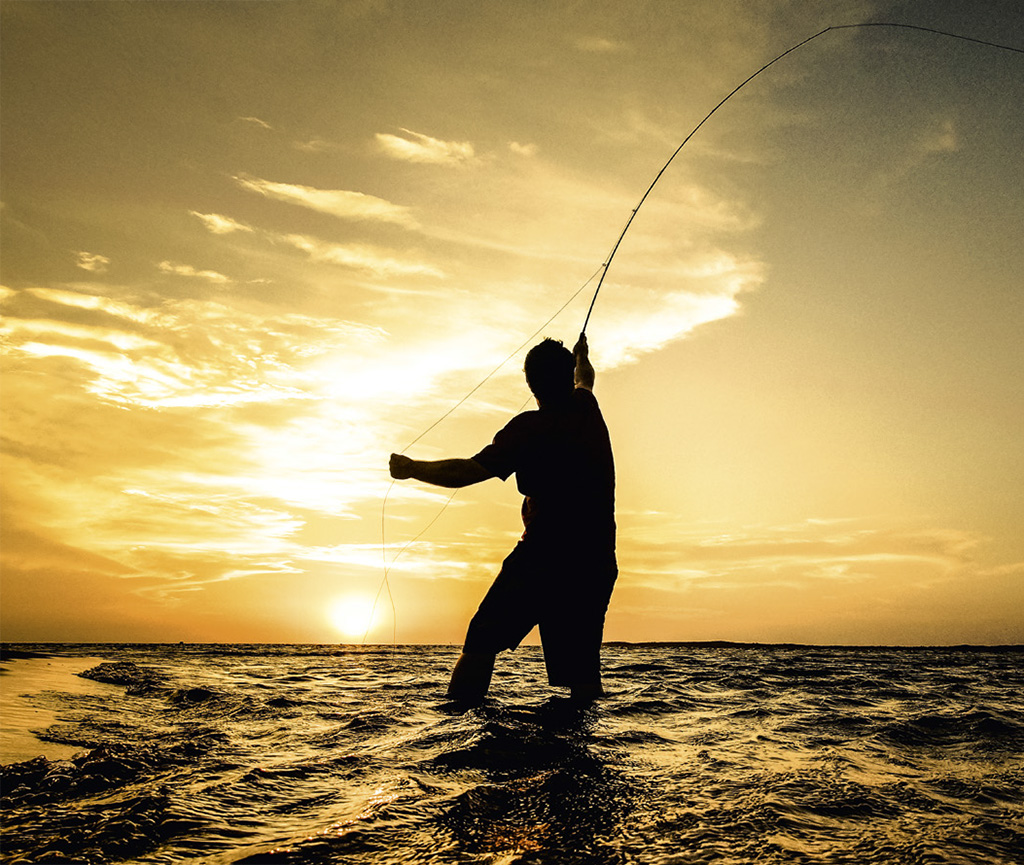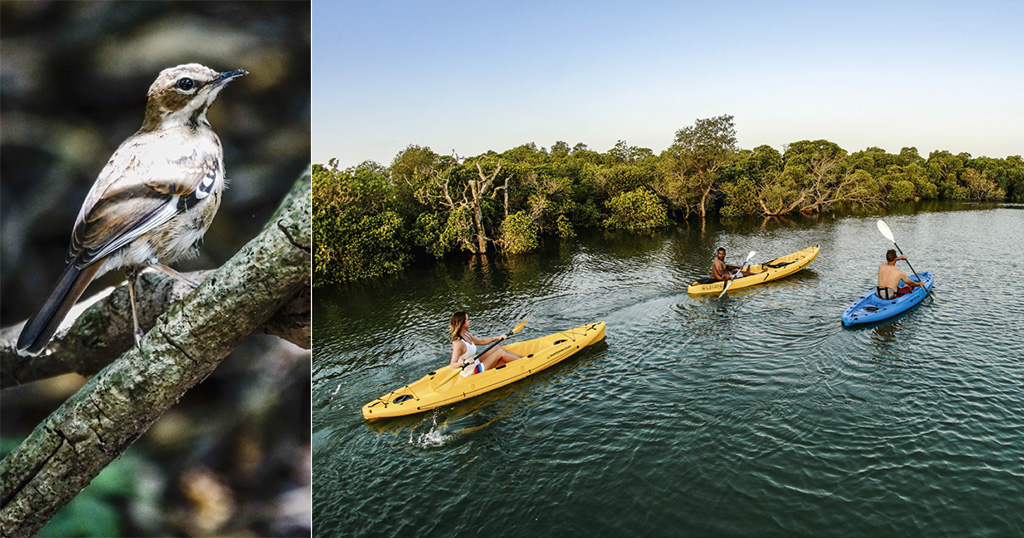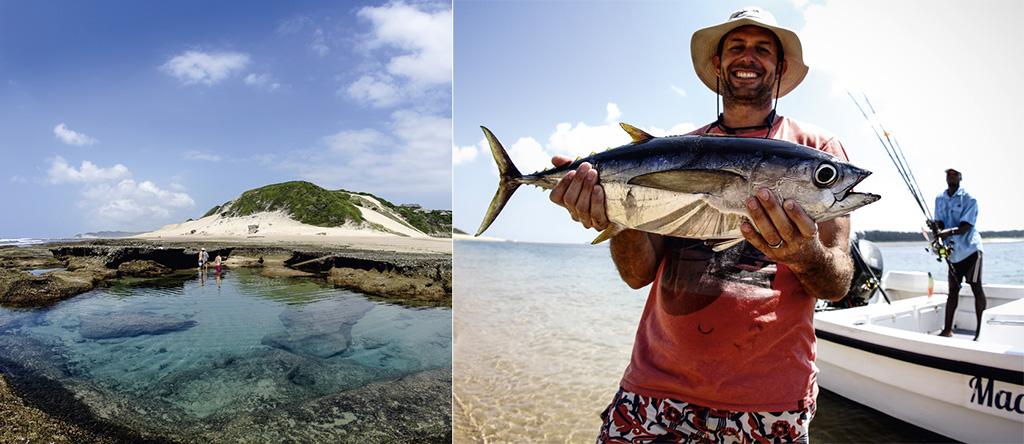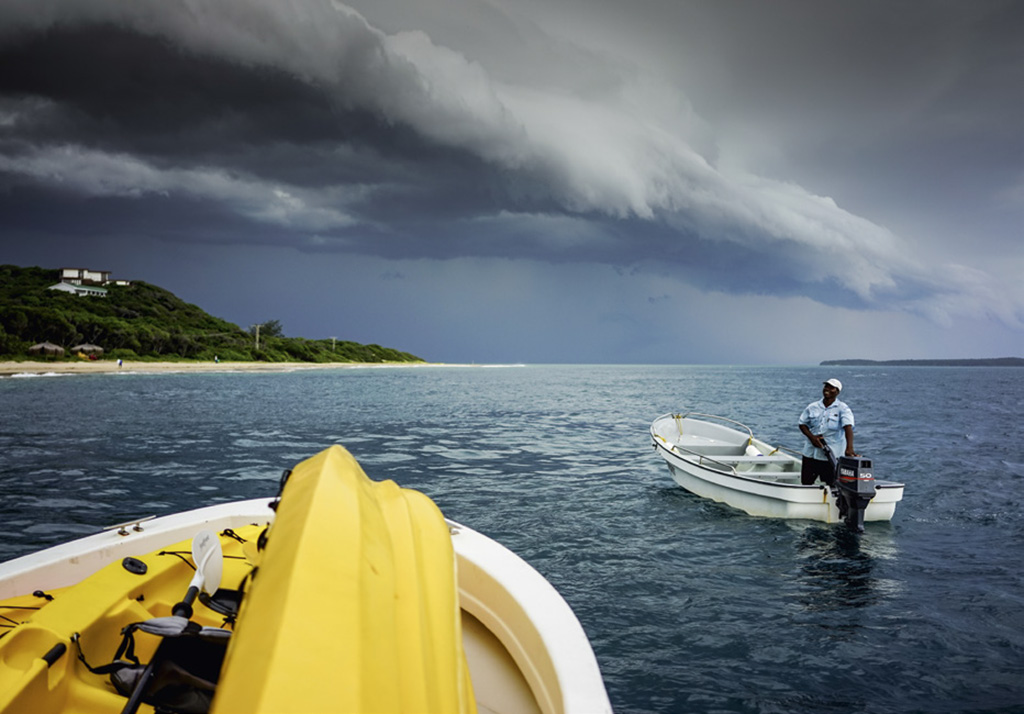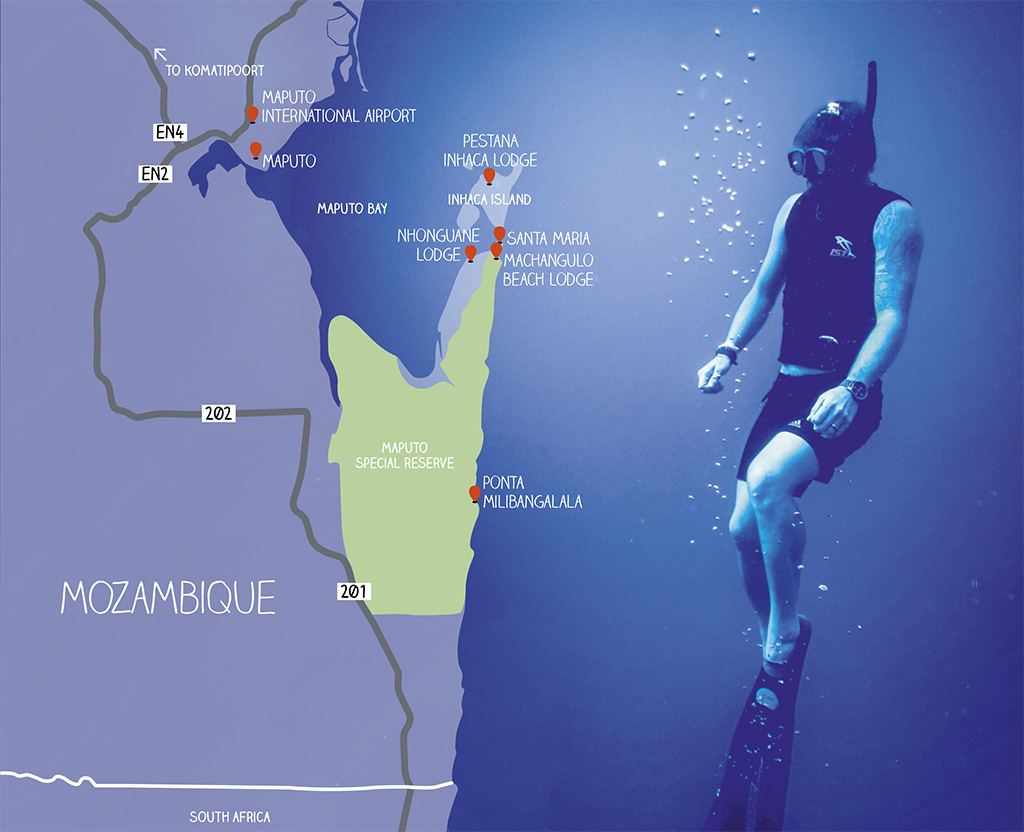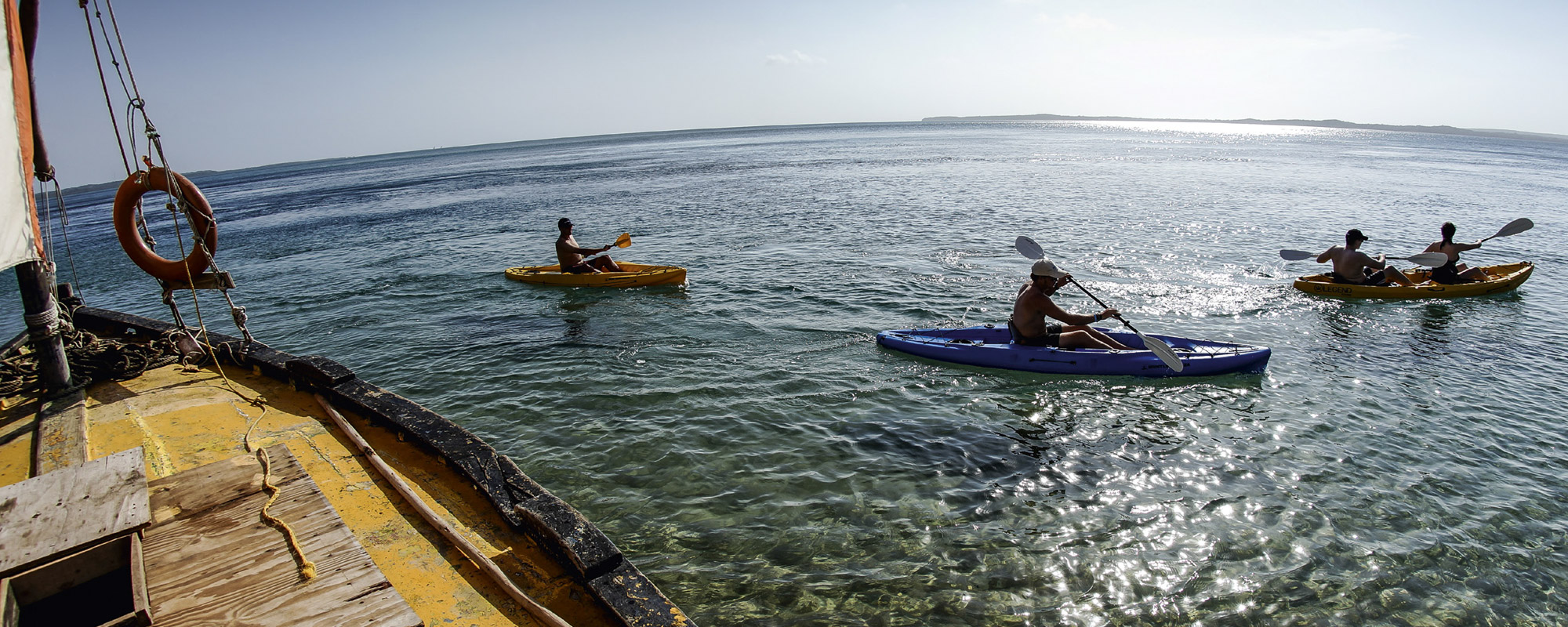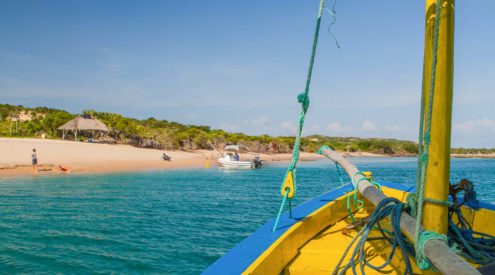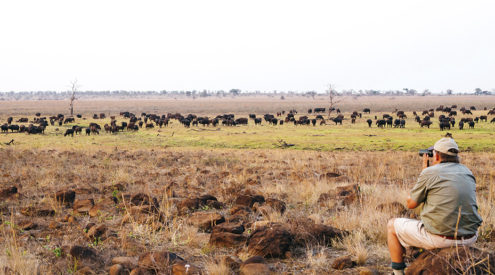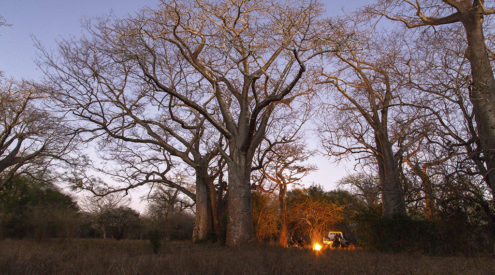Just one flight, one hour away from OR Tambo, is Maputo, Mozambique. And only a 90-minute boat ride from the bustling city is Machangulo, a stunning natural playground.
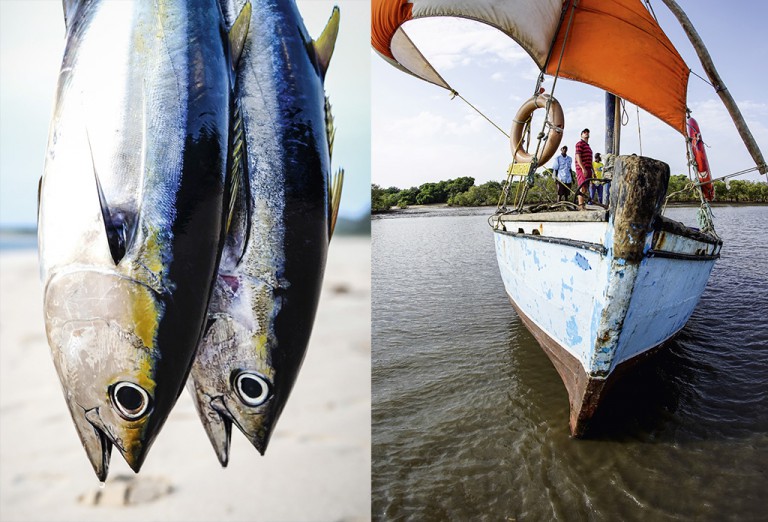
LEFT The bounty of the ocean, fresh from the boat to dinner tables. RIGHT Colourful dhows dot the mangrove mudflats at Santa Maria and can easily chartered for a day of fishing or sailing.
Why it’s worth the trip
- The fishing is excellent from rock angling, salt-water fly fishing to deep-sea fishing.
- It’s a birdwatcher’s paradise, home to the full gamut of waders, forest and pelagic species.
- Snorkelling and diving is some of the best along this pristine African coastline.
- The water is 27 degrees Celsius all year round.
- It’s a great family destination thanks to a variety of activity – from laid-back paddling on the beach for little ones to canoeing and diving for adults – and accommodation options.
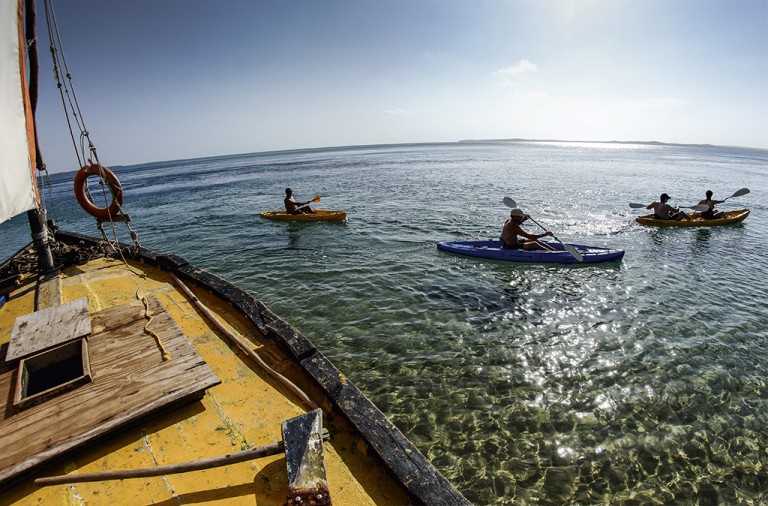
Visitors to Machangulo can easily combine a day filled with adventures, such as dhow sailing, kayaking, sport fishing and snorkelling.
The magic of Machangulo
‘Red-eye”. The word doesn’t come close to summing up how much I hate those pre-dawn flights. Bleary-eyed zombies stagger through the airport clutching cups of overpriced coffee in an attempt to fire up their synapses. Then there are queues, questions, bus rides, more queues, the dread of the Idiot Lottery for the seat next to you, airline food … and eventually there is OR Tambo, a neo-modern Mordor processing facility, where the whole business starts again (if you’re fortunate enough merely to be passing through).
I am, thank goodness, as I’m headed for Maputo, and these days it is but a quick hour-long flip from Jozi. And as soon as you touch down in Mozambique’s capital, you get the feeling your day is taking a turn for the better: sensual colonial architecture, a café-latte lilt to the language and a spice-me-nice flair to the food.
This is Mozambique’s way of whispering a sultry ‘Bem-vindo!’ to welcome you to what could just be the closest thing to a postcard-perfect Brazilian beach here on the African continent. As may be expected, Maputo does provide the odd snarl, but generally her bark is far worse than her bite.
Here’s a tip: no matter how hot you feel, don’t let your elbow hang out of the vehicle and don’t stack your luggage on the back seat. Both of these ‘offences’ will help to line the pockets of strategically placed traffic policemen with the uncanny ability to materialise from behind any palm tree.
So now you’ve had the bad news, let’s get to the good stuff. Despite a legacy of war and hard times, Mozambique rates as an ‘Africa for beginners’ destination. Sure, the rush-hour traffic, dodgy officials and sometimes poor infrastructure come as part of the deal, but the fact that Mozambique is arguably one of the fastest growing economies in Africa is obvious as soon as you step into the re-vamped Maputo airport.
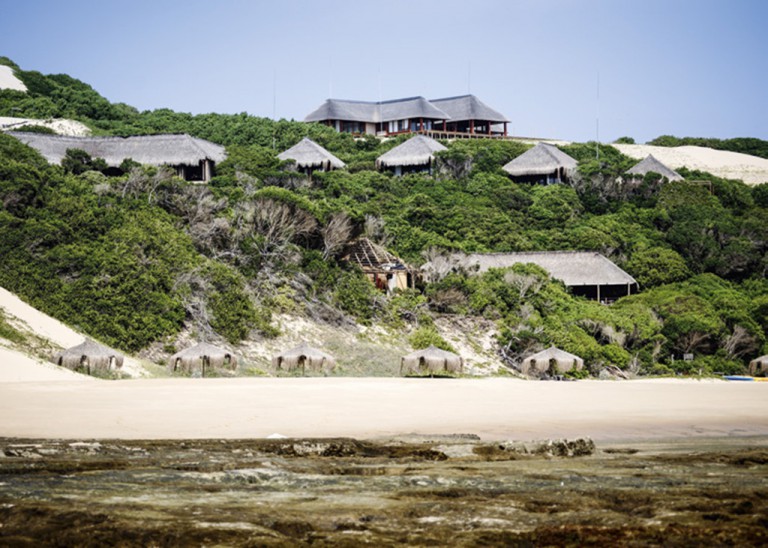
Machangulo Beach Lodge nestles in the dune forests.
This is also where you will have your first contact with Machangulo Beach Lodge’s members of staff and, before you know it, they’ll have you down at the Clube Naval and boarding an ocean transfer across Baie de Lourenço Marques all the way to the scenic Machangulo peninsula itself.
Fast-forward through 90 minutes of comfortable cruising on the bay, with Portuguese and Inhaca islands looming ever larger on the horizon. The water takes on a cerulean hue and the reception on the beach is warm (both in sentiment and temperature), and within a few minutes you find yourself comfortably ensconced in a private villa set deep in sand-forested dunes.
One thing you can bargain on is that you won’t be spending a huge amount of time indoors. No, siree – this is outside weather at its best, and the range of outdoor activities will keep you on the go from dawn to dusk.
‘Come on, the tide is about to turn; you’ve got half an hour before the water clears for the best snorkelling you’ll ever get to do in your life.’ That’s Conrad Greenshields, the activities manager at Machangulo Beach Lodge, and he’s got a boat ready to whisk me across Hell’s Gate channel to the Inhaca Island marine reserve.

The whole family can join in safe and accessible rock pooking and snorkelling on the beach right in front of the hotel, while happiness is fresh sushi you caught yourself off the Machangulo Beach Lodge fishing charter.
Let me be honest here; the proximity of Machangulo to the burgeoning capital city and Inhaca Island meant I didn’t expect the greatest underwater show on Earth. After all, wouldn’t there be thousands of hunter-gatherers stripping the coast of all its natural resources?
Wrong, on both counts. There was hardly a soul to be seen on Machangulo’s beaches on any given weekday morning. Sure, the weekends were busier, but overall it was as quiet here as on any beach in the Quirimbas or Bazaruto archipelagos.
And once you slip on your mask and dip below the surface of the Big Blue, a world of wonder awaits. Mercurial schools of kingies refract like silvery snow blizzards against the aquamarine backdrop while tropical fish of every size, colour and description abound.
Batfish, pipefish, lion fish, regal angelfish, parrotfish, stripy little Nemo buggers … I hyperventilate like a kid on a first visit to an amusement arcade, then gurgle with delight when two giant trevally shoot like agro pit bulls from among some rocky pinnacles before submarining off into the jade netherworld.
This is a world-class underwater experience where you basically drift on fast-flowing tides pumping clear water into the bay from the Indian Ocean. The abrupt drop-offs mean you are never more than a few metres from terra firma, so less confident swimmers can stick to shallower water between the rocky pinnacles and reefs lining the Inhaca shore.
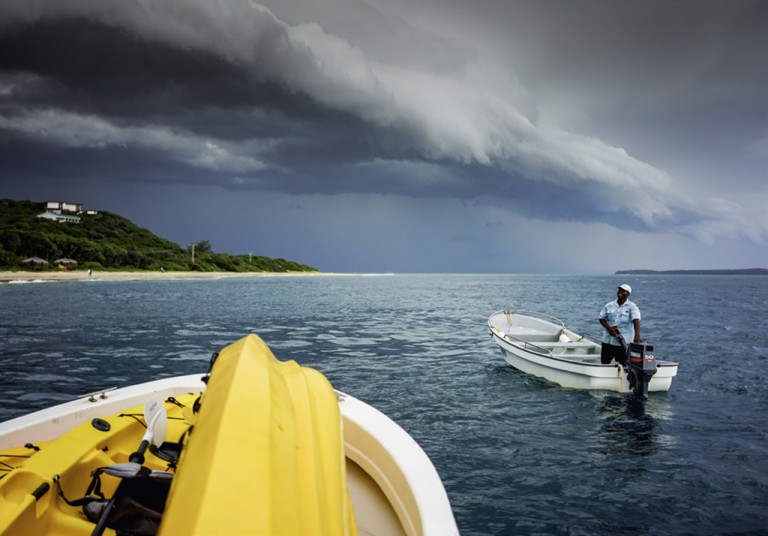
A tropical storm rolls in over the peninsula.
Now, I could have floated in the 27 degrees Celsius (yes, read my lips, especially you Capetonians) water for the rest of the day, but an adventure menu of note awaited. The birding on the peninsula is off the scale, with the full gamut of waders, forest and pelagic species to tick off. Although early mornings generally prove more rewarding, my afternoon sojourn into the sand forest delivers big time: Knysna turaco, slender bulbul, eastern nicator and bearded scrub robin pop up in the first hour, with a spotted bush snake thrown in for good measure.
Batfish, pipefish, lion fish, regal angelfish, parrotfish, stripy little Nemo buggers … I hyperventilate like a kid on a first visit to an amusement arcade
A sundowner swim and sumptuously spicy peri-peri chicken kebabs segue into a couple of hours of star-trail photography before I head off to bed. This could be an adventure in itself, with spotted genet, Verreaux’s eagle owl and African rock python on the loose. I eventually drift into dreamland to the distant calls of fiery-necked nightjars and the white noise of waves crashing onto the beach.
My wake-up call, however, does not go quite as expected. My buddy Mike and I are keen to get to the local village of Santa Maria around dawn in order to organise a dhow trip, so I sneak onto the wooden deck outside my chalet and retrieve my board shorts from where they’ve been drying. I slip them on and – as I amble to the bathroom to go and brush my teeth – I realise something is seriously amiss. What at first feels like a tiny thorn tickling my nether regions escalates into a feeling akin to a hot coal burning my backside, and in a move that would make a stripper proud, I do a mid-air flick flack while removing the shorts.
The culprit is a five-centimetre-long scorpion, fortunately not of the severely venomous kind. A liberal application of Tiger Balm sorts out the damage to my nether regions (but not my ego, as the story soon spreads like wild fire).
Be that as it may, Mike and I head off to Santa Maria, watching the sun rise over a rickety pier where trading dhows are unloading goods brought from the markets in Maputo. Fresh bread is being baked in an old clay oven off the village square, and for an hour we stroll around to soak up life in what is truly a ‘slow town’.
Then breakfast, some rock pooling, spinning for cuta and a mid-morning siesta beneath the thatched beach umbrellas … life doesn’t get much better. It does, however, get more exciting if you want it to.
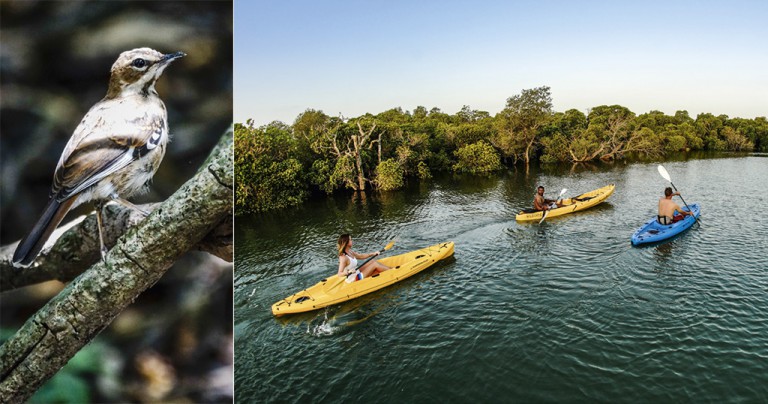
LEFT A brown scrub robin in the coastal dune forest. RIGHT Birding while sea kayaking the mangrove forests of Inhaca Bay.
While the lodge guests prepare to set off for a sand-bar picnic and a dhow sail, I grab a sea kayak and blade across the bay. The tide pushes in via Hell’s Gate, there’s not a breath of wind and I feel suspended in an aquamarine dream. It takes about 45 minutes to reach the mangrove channels along the far end of the bay, and as the tide rises I drift into these emerald swamps.
A chorus of squawks, caws and reedy whistles greets me as I glide between green walls of vegetation rising up from the rippling tidal flow. Cormorants scud off like feathered missiles at my approach, while grey and green-backed heron crane their regal necks for a better view.
Egrets spiral skywards like snowflakes on the breeze, while pied kingfisher make use of the avian mayhem to arrow into the shallows. With the orange glow of the setting sun suffusing the horizon, I round a bend to find a flock of greater flamingos hot-stepping like a troupe of flamenco dancers.
As I near them, they spread their cerise wings and take off against the fiery sky as if in a salute to what must rate as a near-perfect day here in Africa. ‘Muito obrigado, Mozambique, vou voltar (I will be back)’. Yup, no doubt about it.
Getting to Machangulo
There are daily flights from Joburg and Durban to Maputo, but the price varies depending on the season and availability. See travelstart.co.za for good comparative pricing. If you’re in an adventurous mood, turn your trip into a beach-and-bush experience by driving via the Maputo Special Reserve. www.peaceparks.co.za
When to go to Machangulo
Southern Mozambique remains unaffected by tropical weather throughout the year, so there’s no need to worry about cyclones and the like. It goes without saying that Machangulo is an excellent escape from the South African winter, but other natural events to consider when planning your trip are the annual whale migration from June to November and the turtle- hatching season from December to March.
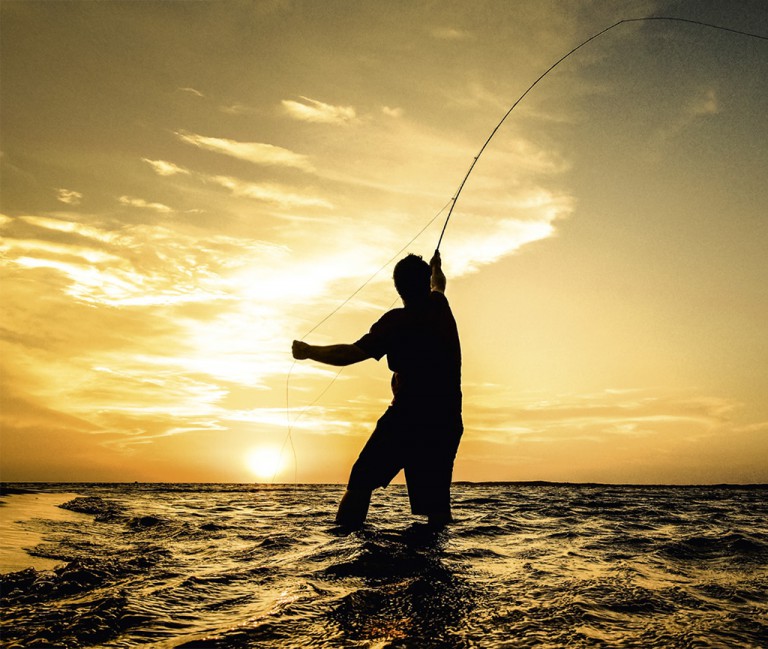
Fly-fishing in front of the Machangulo Beach Lodge at sunset.
Things to do in Machangulo
1. Snorkel
The sea world of the Inhaca Island marine reserve. Machangulo Beach Lodge offers quick and easy access via kayak or a boat transfer to the adjacent reserve, or day tours can be arranged from Maputo via operators such as Dana Tours.
2. Go birdwatching
Around the peninsula and see wader and pelagic species. Where else in the world can you spot a shy albatross, soft-plumaged petrel, broad-billed prion, flesh-footed shearwater, red-tailed tropicbird, black-crowned night heron, woolly-necked stork, osprey, Amur falcon, greenshank and bar-tailed godwit on the same day?
3. Sail in a dhow
Cruises can be arranged either by speaking to dhow captains at the harbour in Santa Maria or by booking onto a dhow owned by Machangulo Beach Lodge. The latter option can be planned in conjunction with a sand-bar picnic, set up with tables and shade awnings on a remote and private sandspit at low tide. From R245 per person (excluding picnic).
4. Go kayaking
In the bay. The lodge has boats and equipment available for use by guests (free).
5. Get hooked on fishing
Options abound, from rock angling, salt-water fly fishing or deep-sea fishing and spinning. Most establishments offer rods for hire. Fishing is from R1227 per hour (maximum six) including drinks, snacks and fuel.
6. Visit Maputo Special Reserve
Machangulo borders the Maputo Special Reserve, which is accessible from the peninsula by constantly changing sand tracks (a 4×4 is a prerequisite in order to negotiate the reserve). Alternatively, it can be accessed by road (the 201) and is about four hours from Kosi Bay or around five hours from Komatipoort. Driving to Machangulo from Maputo is also possible via the reserve and takes a minimum of six to seven hours.
The reserve is extremely scenic and has a diverse range of eco-systems, including lakes, wetlands, swamp forests, grasslands, mangrove forests, coastline and dunes. Although shy and often elusive, you may spot anything from hippo, reedbuck, zebra, giraffe, kudu, duiker, bush pig and crocodile to leopard, serval, honey badger and porcupine, to name a few. There are also ellies which can be easily provoked. The reserve has approximately 350 different bird species.
Visitors need to be fully self-sufficient due to the lack of facilities and infrastructure within the park – note that cell phone signal is poor to non-existent. Visitors are able (and indeed are encouraged) to hire local people to assist with all camping needs, from helping to put up tents, washing dishes, or collecting firewood and water. There is an exclusive natural beach lodge under construction at Ponta Chemucane (aka Anvil Bay) but this is yet to be completed.
What to eat in Machangulo
Expect a bit of a bite with both the seafood and chicken dishes for which this ex-Portuguese colony is famed. Peri-peri is the name of the game, and a liberal amount of chilli is added to everything. Even the smallest village bakes fresh bread and if you get there early, chances are you’ll be able to get your hands on some quality pão, the Mozambican version of Portuguese rolls which are crispy on the outside and soft inside.
Accommodation in Machangulo
Machangulo Beach Lodge has, among other accommodation, eight private thatched villas situated well apart from each other at the foot of a pristine sand-forested dune. From R2250 per person, full catering excluding bar drinks and activities. Contact Mike Richardson and Vicki Crookes at African Quiver for information, or get them to plan and coordinate your trip for you.
Nhonguane Lodge near Santa Maria offers safari-style tented camps or try the beachfront bungalows, both from R700 per person sharing.
Plan B is to venture onto Inhaca Island, which is a different experience from the peninsula. It is more populated but there are some superb accommodation options: Pestana Inhaca Lodge on the waterfront is from R1656 per person. Nahyeeni Lodge with views of the Bay of Maputo offers self-catering accommodation from R1400 per person.
Ponta Milibangalala is currently the only accommodation in the Maputo Special Reserve. It’s basic, with little more than a pit latrine and a water well. The water is not suitable for drinking. Camping is from R200 per day. Reserve entry is R140 per person, R140 per vehicle and R140 per trailer, and is valid for 48 hours. If you exit the park after 48 hours from entry, you will be charged the same amount again upon exit.
Need to know about Machangulo
It’s important to plan your flights around your boat charter to the Machangulo peninsula, so check its ocean transfer times to ensure it coincides with the tides. Transfers from the airport to the Maputo Marina could take from 45 minutes to a couple of hours, depending on rush-hour traffic, so build this into your planning. If you’re driving to Mozambique, make sure you have all the necessary documentation to prove ownership of your vehicle.
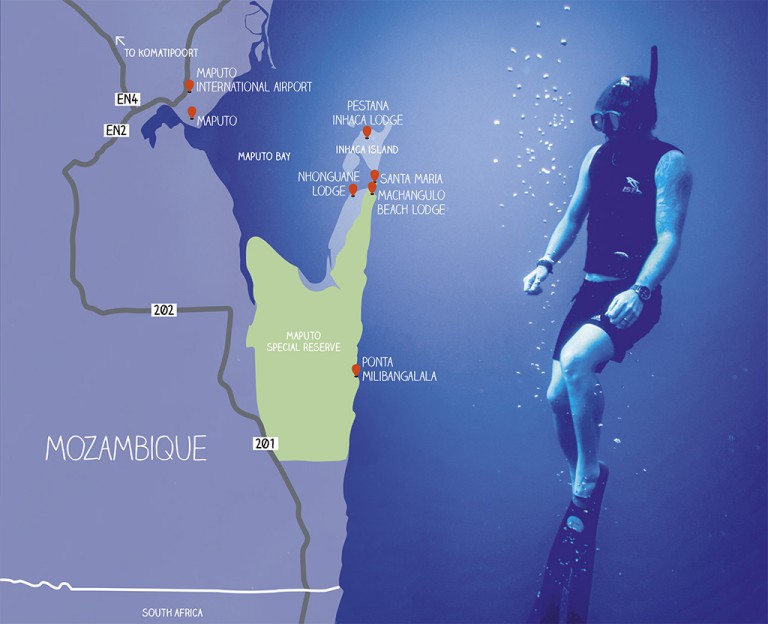
Photo by Jacques Marais.
This article first appeared in the August 2015 issue of Getaway magazine.
All prices were correct at time of publication, but are subject to change at each establishment’s discretion. Please check with them before travelling.




